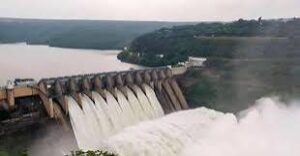Following days of torrential rains and the recent devastation in Maiduguri caused by the collapse of Alau Dam, residents in Nigeria’s littoral states are on high alert over the potential flood disasters with the reported release of excess water from Cameroon’s Lagdo Dam, sparking fears of a repeat of the flooding that ravaged the country in 2022.
The Nigeria Hydrological Services Agency (NIHSA) issued an urgent warning on Tuesday, September 17, 2024, regarding the likelihood of severe flooding that could impact approximately 11 states. These states, all situated along the Benue River basin, include Adamawa, Taraba, Benue, Nasarawa, Kogi, Edo, Delta, Anambra, Bayelsa, Cross River, and Rivers.
NIHSA’s advisory called on residents and government officials to “heighten their vigilance and implement appropriate preparedness measures to mitigate potential flooding impacts that may arise due to an increase in flow levels of our major rivers during this period.”
The warning comes amid reports that water levels in the Niger and Benue Rivers are already rising, despite the Cameroonian authorities’ claim that the release from Lagdo Dam is being conducted gradually.
READ ALSO: Fresh Flood Looms As Cameroon Releases Water From Dam Around Nigeria
Communities in vulnerable areas, such as Irri in Isoko South Local Government Area of Delta State, have already begun relocating from flood plains to higher ground as water levels continue to swell. This proactive measure is being encouraged by officials to prevent casualties and reduce property damage.
In a statement, NIHSA’s Director-General and Chief Executive Officer, Umar Muhammed, cautioned that the discharge from Lagdo Dam is expected to progressively escalate to 1000 cubic meters per second over the next seven days.

This increase is based on inflows from the upstream Garoua River, which serves as a major source feeding into the reservoir and is a significant tributary of the Benue River.
READ ALSO: Maiduguri Flooded As Alau Dam Breaks Down
“The water discharge is anticipated to progressively escalate to 1000m³/s over the next seven days, based on the inflow from the upstream Garoua River, which serves as the primary source into the reservoir and a significant tributary to the Benue River,” Muhammed said, stressing the urgent need for evacuation from high-risk areas.
While the flooding in Maiduguri and other parts of Borno State was not directly linked to the release from Lagdo Dam, the aftermath of the Alau Dam’s collapse has served as a grim reminder of the destructive potential of dam failures.
Officials have warned that the Lagdo Dam, due to its larger capacity and transboundary location, could cause far greater devastation if its release triggers a surge of floodwater downstream.
Confirming the ongoing water release from Lagdo Dam, Ezekiel Manzo, spokesman for the National Emergency Management Agency (NEMA), stated that the current water level rise in River Benue poses a critical threat to communities along its banks.
READ ALSO: Football Fans Urge Dangote To Invest In NPFL Not Arsenal
He acknowledged that the controlled release is necessary to prevent the dam’s capacity from being overwhelmed and possibly collapsing, which would lead to catastrophic consequences.
“A breakage of the dam would cause much damage in Nigeria as we have witnessed recently in Maiduguri with Alau Dam, a much smaller dam compared to the one in Cameroon,” Manzo warned, drawing attention to the potential scale of destruction.
Governments of the affected states are racing to relocate vulnerable populations and establish camps for internally displaced persons (IDPs). With memories of past flood disasters still fresh, there is an urgent call for a coordinated response from both federal and state agencies to mitigate the potential impact.
READ ALSO: JUST IN: FG Increases Corps Members Monthly Allowance To N77,000
As the situation unfolds, local authorities, humanitarian organizations, and residents are bracing for what could be a challenging period ahead, with the looming threat of widespread displacement, loss of property, and potential loss of life.
The coming days will be crucial in determining the extent of the flood’s impact and the effectiveness of preventive measures put in place.

